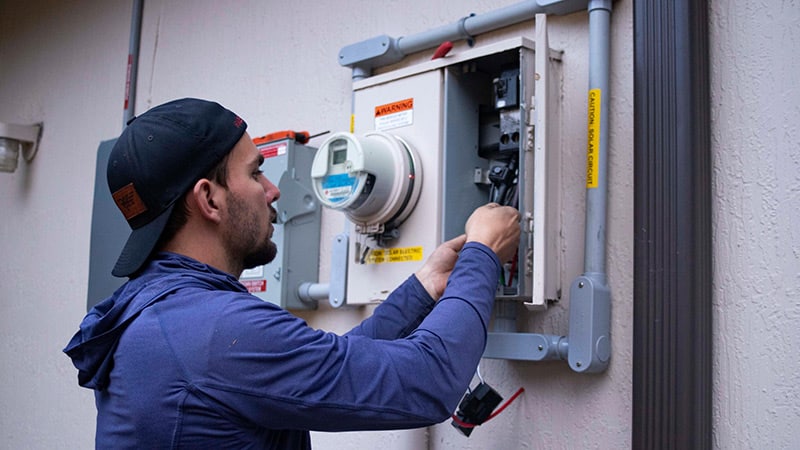How much money is the UK Government spending on retrofit and when are they hoping it will be done by?
The statistics tell their own story about how critically important it will be to undertake sensible and effective retrofitting across the UK’s housing stock over the years ahead. The term “retrofitting” refers to the practice of performing upgrades to existing buildings – such as improving their insulation, replacing windows, and installing more efficient heating and hot water systems – to optimise the property’s energy efficiency.
As cited by the UK Green Building Council (UKGBC), UK homes are some of the oldest and leakiest in western Europe, and yet, 80% of homes that are lived in today will still be inhabited in 2050. This raises the prospect that, without adequate retrofitting measures, residential buildings up and down the UK will continue unnecessarily leaking precious and expensive heat through every roof, wall, and door that isn’t insulated.
But retrofitting isn’t merely crucial for driving down people’s energy bills; the UK Government has stated that in order for its carbon goals to be met, the “vast majority” of the country’s 27 million homes will need to be virtually zero carbon by 2050.
With half of the UK’s homes having uninsulated walls, and some £56 billion in potential health benefits able to be unlocked if a national retrofit strategy is put in place, there is clearly much work for the UK Government to do.
How much funding, then, is the Government actually committing to retrofitting, and what are the timelines for the key retrofitting projects? Let’s take a closer look.
What is the UK Government’s retrofit programme?
The short answer to this question is that there isn’t a single overarching national home retrofit programme in operation. Nonetheless, the UK Government has introduced various policies and programmes over recent years. These have aimed to ensure homes are thermally comfortable, support green jobs, drive down energy bills (and therefore fuel poverty), and enhance the UK’s economic resilience.
Some of these schemes – such as the Sustainable Warmth competition, the Green Homes Grant voucher scheme, and the Social Housing Decarbonisation Fund – are either already closed to new applications or may have been withdrawn by the time you read this.
So, if you are a homeowner, building owner, manager, contractor, or other stakeholder with an interest in discovering the latest sources of Government support for retrofitting, we would urge you to seek out the latest information from relevant departments, such as the Department for Energy Security and Net Zero (DESNZ).
How much funding has the UK Government allocated to retrofitting?
Given the existence of various disparate schemes rather than one overarching national scheme, it is difficult to put an overall number on the UK Government’s commitment to retrofitting. Nonetheless, the Government has set out a range of figures associated with the initiatives it has announced, making clear the scale of its financial commitment.
For example, in March 2023, the Government announced the award of £1.8 billion to improve energy efficiency and reduce the emissions of homes and public buildings across England, through the Social Housing Decarbonisation Fund, Home Upgrade Grant, and Public Sector Decarbonisation Scheme.
It was stated that of this amount, £1.4 billion would be allocated to local authorities, providers of social housing, and charities to upgrade homes and off-grid households with energy-efficient measures.
Another recent retrofitting-related initiative of the UK Government is the Great British Insulation Scheme (GBIS). This initiative, also announced in March 2023 and set to run until March 2026, has been described as worth £1 billion, and aims to help approximately 300,000 households across the UK with the cost of installing new home insulation.
What are the main retrofit schemes funded by the Government?
The below are examples of retrofit-related schemes that were in operation by the UK Government at the time of this article being written. Again, we would always emphasise the importance of you seeking out the latest information from official sources, such as the UK Government website.
The Great British Insulation Scheme (GBIS)
As aforementioned, the GBIS was conceived as a means of helping households across the UK to cover the costs of installing new home insulation. The fitting of such insulation is a key plank of efforts to bolster the energy efficiency of UK homes and reduce energy bills.
Homeowners, landlords, and tenants whose home has an energy performance certificate (EPC) of D to G, and who are in Council Tax bands A to D in England or A to E in Scotland or Wales, may be eligible to get free or cheaper insulation through this scheme.
Forms of insulation that those accessing the scheme may be able to have installed encompass (but are not limited to) cavity wall insulation, solid wall insulation, loft insulation, and flat or pitched roof insulation. Further information on eligibility and the application process can be found on the GOV.UK website.
The Energy Company Obligation (ECO)
The ECO is a Government energy efficiency scheme in Great Britain, aimed at combating fuel poverty and helping to lower carbon emissions. There have been four iterations of the scheme so far, with the fourth one – ECO4 – applicable to measures installed from 1st April 2022, set to cover a four-year period until 31st March 2026.
The scheme obligates medium and large energy suppliers to promote measures that improve the ability of low-income, fuel-poor, and vulnerable households to heat their homes.
Help for energy-saving home improvements may be available to those who claim certain benefits and live in private housing (for example, who own their home or rent from a private landlord), or who reside in social housing. Such improvements could include insulation work or the fitting of new boilers; more information is available on GOV.UK.
The Boiler Upgrade Scheme (BUS)
The BUS provides successful applicants with a grant to cover part of the cost of a heat pump or biomass boiler as a replacement for a fossil fuel heating system such as an oil, gas, electric, or liquefied petroleum gas (LPG) system.
The scheme is open to people looking to retrofit homes and non-domestic properties in England and Wales. One grant is available per property, with £7,500 able to be put towards an air source heat pump or a ground source heat pump, or £5,000 towards a biomass boiler.
£450 million of grant funding is being made available via this scheme over three years from 2022 to 2025. More information on eligibility and how to apply can be found at GOV.UK.
The Home Upgrade Grant (HUG)
This initiative – funded by the Government’s Local Authority Delivery scheme – enables homeowners in England to get free energy-saving improvements made to their property, as long as they do not use a gas boiler as their main heating system.
An applicant’s home must also have an EPC rating of D, E, F, or G. Furthermore, it is normally required for the applicant household’s income to be £36,000 per year or less.
Those who are successful in their application for a HUG could have improvements such as the installation of wall, loft, and underfloor insulation, air source heat pumps, and electric radiators paid for by their local council. Again, GOV.UK has further details.
How is the funding being distributed across the UK?
To give an example from just one scheme, according to Government-published statistics, between the GBIS’s commencement at the end of March 2023 and the end of April 2024, there were 11,600 measures installed across 9,400 households.
In terms of GBIS delivery by region, the highest regional delivery was seen in the South East and Yorkshire and The Humber regions, each recording around 1,700 measures, or 15% each of the whole. Next up in the ranking was the North West, with approximately 1,300 measures (11%).
The Yorkshire and The Humber region recorded the highest average rate of households upgraded under the initiative – 60 per 100,000 households.
What is the timeline for completing Government-funded retrofit projects?
2050 is clearly a key date for realising many essential retrofitting projects in the UK; the Government aspires to all the country’s emissions reaching net zero by the century’s midpoint. It is believed that some 27 million houses up and down the country will need to be retrofitted in order to meet this target, which seems a gargantuan task.
Sure enough, there has been some criticism of the speed of work to retrofit UK properties according to the timelines needed. The relatively small number of homes to have benefitted so far from the GBIS, for example, has led to concerns that the initiative is not on track to reach its 300,000-home target by 2026.
What are the benefits of Government-funded retrofit projects for homeowners?
Putting aside the UK Government’s own first priorities, if you are reading this as a homeowner, there are many excellent reasons to carry out research into the various support schemes and initiatives that may be available to homeowners like you, to assist with retrofitting.
Many homeowners in the UK would love to tap into the abundant benefits of having energy-efficient upgrades carried out at their property, which range from reduced utility bills to increased property value for when they next look to sell their home. However, the biggest barrier to them doing so may well be the high upfront cost.
With the longer-term benefits of retrofitting including a positive impact on the environment amid the ongoing climate emergency, and the contribution such projects make to national energy goals, the UK Government has plenty of reason to keep offering schemes like the above for a long time to come.
So, it is well worth looking at official and trusted sources of information on the latest Government-funded retrofitting programmes, such as the GOV.UK website, to keep up to date on the latest funding opportunities as they become available. You might be pleasantly surprised by your ability to satisfy the eligibility criteria for whatever scheme(s) catch your eye.
Conclusion: it is a good idea to stay alert to the Government’s broad-ranging retrofitting schemes
As we have set out in this article, the UK Government is throwing some serious financial weight – and policy heft – behind retrofitting-related initiatives and programmes, in recognition of the huge importance of such projects for satisfying its carbon goals over the years ahead.
By taking steps to keep informed about the newest such schemes as they are launched, you can place yourself in the best possible position to take advantage of them, whether you are a homeowner, a contractor, or another key stakeholder.
As a provider of accredited asbestos services here at Oracle Solutions, we would be pleased to play our own part in ensuring the safety and legal compliance of any retrofitting project you oversee at your property. To learn more, please don’t hesitate to contact us today.

Written by Mark Carter
Mark Carter is a renowned expert in asbestos management, offering clients vital guidance on compliance and safety. His expertise is invaluable for navigating asbestos regulations, ensuring both safety and legal adherence. Mark's role is central in providing effective asbestos-related solutions, helping clients achieve their business objectives with an emphasis on regulatory compliance and safety in asbestos management.



